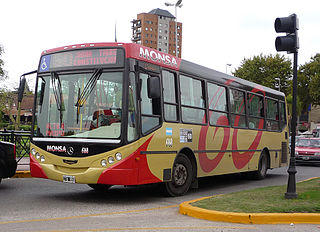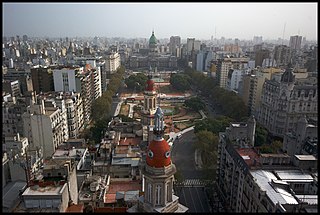
The Buenos Aires Underground, locally known as Subte, is a rapid transit system that serves the area of the city of Buenos Aires, Argentina. The first section of this network opened in 1913, making it the 13th earliest subway network in the world and the first underground railway in Latin America, the Southern Hemisphere, and the Spanish-speaking world, with the Madrid Metro opening five years later, in 1919. As of 2023, Buenos Aires is the only Argentine city with a metro system.

Balvanera is a barrio or neighborhood of Buenos Aires, Argentina.

Line A is the oldest line of the Buenos Aires Underground. Opened to the public on 1 December 1913, it was the first underground line in South America, the Southern Hemisphere and the Spanish-speaking world. It made Buenos Aires the 13th city in the world to have an underground transport service. The line stretches 9.8 km (6.1 mi) from Plaza de Mayo and San Pedrito and runs under the full length of the Avenida de Mayo and part of the Avenida Rivadavia, and is used by 258,000 people per day.

Line D of the Buenos Aires Underground runs from Catedral to Congreso de Tucumán. The line opened on 3 June 1937 and has been expanded to the north several times. The line is currently 11 km long and has 16 stations, while running approximately parallel to the city's coastline.

Núñez is a barrio or neighbourhood of Buenos Aires, Argentina. It is on the northern edge of the city on the banks of the Rio de la Plata. The barrio of Belgrano is to the southeast; Saavedra and Coghlan are to the west; and Vicente López, in Buenos Aires Province, is to the north.

Constitución railway station is a large railway station in Constitución, a barrio in central Buenos Aires, Argentina. The full official name of the station is Estación Plaza Constitution reflecting the fact that the station is located opposite Constitution Square, two kilometers to the south of the Obelisco landmark. The ground floor of the station has fourteen tracks and the floor below has two tracks for the Buenos Aires Underground.

The Colectivo 60 commenced operations in 1931 and runs from Constitución station, in the centre of the city of Buenos Aires, Argentina to the Tigre Club in the partido of Tigre. The service is operated by Transportes Larrazabal C.I.S.A, DOTA and MOTSA and the identifying colour of the buses is white and red with black details.

Retiro is a barrio or neighborhood in Buenos Aires, Argentina. Located in the northeast end of the city, Retiro is bordered on the south by the Puerto Madero and San Nicolás, and on the west by the Recoleta.

Once railway station is a large railway terminus in central Buenos Aires, Argentina, in the barrio of Balvanera.

According to the World Travel & Tourism Council (WTTC) the travel and tourism sector of Argentina was moving towards recovering its pre-covid pandemic contribution to GDP in mid-2023, led by Buenos Aires.
There are many landmarks in Buenos Aires, Argentina some of which are of considerable historical or artistic interest.

Congressional Plaza is a public park facing the Argentine Congress in Buenos Aires. The plaza is part of a 3 hectare open space comprising three adjoining plazas to the east of the Congress building. The Kilometre Zero for all Argentine National Highways is marked on a milestone at the plaza.

Plaza Miserere is a station on Line A of the Buenos Aires Underground. The station is located between Alberti and Loria / Pasco stations on the A line underground. Plaza Miserere has interchange with Once underground station of the H line and connection to the Sarmiento line commuter rail service within Once railway station, the central station of the Domingo Faustino Sarmiento Railway.

Catedral is a terminal station of the Line D of the Buenos Aires Underground. From here, passengers may transfer to the Perú station on Line A and the Bolívar station on Line E.

Plaza Italia station is part of the line D of the Buenos Aires Underground. It is located at the intersection of Avenida Santa Fe and the roundabout surrounding Plaza Italia in Palermo. The station was opened on 23 February 1940 as part of the extension of Line D from Tribunales to Palermo.

Perú is a station on Line A of the Buenos Aires Underground. Passengers may transfer from here to the Catedral Station on Line D and to the Bolívar Station on Line E.

Federico Lacroze was an Argentine businessman and railway entrepreneur of French descent. He created the first tram line in Buenos Aires and his Buenos Aires Central Railway helped link the provinces of Entre Ríos, Corrientes and Misiones by rail to Argentina's capital. Lacroze is buried in La Recoleta Cemetery, Buenos Aires.

The Palace of the Argentine National Congress is a monumental building, seat of the Argentine National Congress, located in the city of Buenos Aires. It is located in the barrio of Balvanera at its limit with Monserrat, an area informally known as the Congreso neighbourhood.

The first trams in Buenos Aires began operating in 1863 in what quickly became a vast network of tramways with the city being known as the "City of Trams" for having the highest tramway-to-population ratio in the world. In the 1920s, Buenos Aires had 875 km (544 mi) of tramways and 99 tram lines using 3000 carriages running throughout the city. By 1963, the vast majority of the network began to be dismantled, though some minor tram services continue in the city today.






















